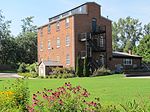Darlington Nuclear Generating Station

Darlington Nuclear Generating Station is a Canadian nuclear power station located on the north shore of Lake Ontario in Clarington, Ontario. It is a large nuclear facility comprising four CANDU nuclear reactors with a total output of 3,512 MWe when all units are online, providing about 20 percent of Ontario's electricity needs, enough to serve a city of two million people. The reactor design is significantly more powerful than those used in previous CANDU sites at Pickering and Bruce, making its 4-unit plant the second-largest in Canada behind the 8-unit Bruce. It is named for the Township of Darlington, the name of the municipality in which it is located, which is now part of the amalgamated Municipality of Clarington. The plant began construction in September 1981 and planned to start initial operations in 1985. Several delays ensued, and the construction start on Units 3 and 4 was put off until 1984 and 1985. Unit 2 entered operation in 1990, followed by Unit 1 in 1992, and Units 3 and 4 in 1993. The delays and resulting cost overruns have made Darlington a primary case study for the anti-nuclear movement in Canada, and was one of the main reasons Ontario Hydro was broken up in 1999 and its debts paid off by special billings. After initial operations and shakeout, it is often among the most reliable plants in the world in terms of capacity factor. As of 2023, the plant is undergoing a mid-life upgrade, with two units completed and the second two expected to complete in 2026. Room for a second four-reactor unit had been in place since the original site selection, with a large area to the east of the current plant set aside for what was known as Darlington B. In 2006, Ontario Power Generation began the process of applying to build a two-unit plant on the B site. This project was cancelled in 2013 when the estimated cost was far beyond initial projections. In 2020 plans started to install a much smaller BWRX-300 small modular reactor install on the B site, which are ongoing as of 2023.
Excerpt from the Wikipedia article Darlington Nuclear Generating Station (License: CC BY-SA 3.0, Authors, Images).Darlington Nuclear Generating Station
Darlington Nuclear Station, Clarington
Geographical coordinates (GPS) Address Nearby Places Show on map
Geographical coordinates (GPS)
| Latitude | Longitude |
|---|---|
| N 43.872777777778 ° | E -78.719722222222 ° |
Address
Darlington Nuclear Station
L1C 3K3 Clarington
Ontario, Canada
Open on Google Maps



